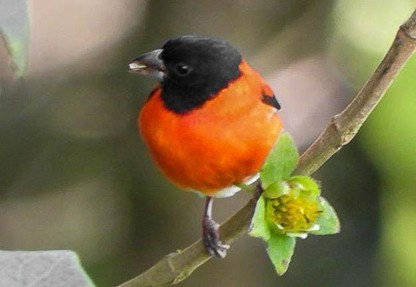Ampliación de la distribución del Cardenalito (Spinus cucullatus) en Colombia y primer registro en el departamento de La Guajira
DOI:
https://doi.org/10.59517/oc.e591Keywords:
High dense forest, Lower Guajira, news locations, Perijá massifsAbstract
We reported the expansion of the distribution of the cardinal (Spinus cucullatus) in Colombia and the first records for the department of La Guajira are presented. This species is highly threatened by illegal trafficking and their habitats are fragmented. Its populations are concentrated in western and central Venezuela. In Colombia it had only been recorded in the municipalities of Cúcuta and Los Patios, in the department of Norte de Santander. Several observation events of at least 14 individuals are described, occurring since 2008 in the municipality of Fonseca, La Guajira, the discovery of this population represents an important opportunity for the conservation of this species within the national territory.
Downloads
References
Arvelo, M., M. Braun, B. Coyle, M. Cedeño, Z. Díaz, K. Rodriguez-Clark, J. Miranda, A. Sanchez-Mercado, R. Rodriguez-Ferraro & B. Sucre. 2018. Strategy for the global conservation of the Red Siskin (Spinus cucullatus).: 35.
BirdLife International. 2018. Spinus cucullatus. The IUCN Red List of Threatened Species 2018: e.T22720374A132138099.
BirdLife International [online]. 2024. Species factsheet: Spinus cucullatus. <http://datazone.birdlife.org/species/factsheet/red-siskin-spinus-cucullatus> (1 February 2024).
Coats, S. & W.H. Phelps. 1985. The Venezuelan Red Siskin: Case History of an Endangered Species. Ornithological Monographs 36: 977–985.
Collar, N.J., L.P. Gonzaga, N. Krabbe, A. Madroño Nieto, L.G. Naranjo, T.A. Parker & D.C. Wege. 1992. Threatened birds of the Americas. The ICBP/IUCN Red Data Book, 3rd ed., part 2. International Council for Bird Protection, Cambridge.
CORPOGUAJIRA & PRN-USAID. 2021. Plan de Manejo del Distrito Regional de Manejo Integrado Serranía de Perijá. Riohacha.
Corporación Autónoma Regional de La Guajira – Corpoguajira. 2024. Base de datos tráfico de fauna silvestre CORPOGUAJIRA - seccional Fonseca. Respuesta Rad. No. 202409303440087621 de 2024. Fonseca, La Guajira.
Hilty, S. 2021. Birds of Colombia. Lynx and BirdLife International Field Guides. Linx Edicions, Barcelona.
Hilty, S.L. & W.L. Brown. 2009. Guía de las aves de Colombia. Princeton University Press, American Bird Conservancy-ABC, Universidad del Valle, Sociedad Antioqueña de Ornitología-SAO, Cali.
IDEAM. 2010. Leyenda nacional de coberturas de la tierra. Metodología CORINE Land Cover adaptada para Colombia, escala 1:100.000.
IDEAM, IGAC & CORMAGDALENA. 2008. Mapa de Cobertura de la Tierra Cuenca Magdalena-Cauca: Metodología CORINE Land Cover adaptada para Colombia a escala 1:100.000. Instituto de Hidrología, Meteorología y Estudios Ambientales, Instituto Geográfico Agustín Codazzi y Corporación Autónoma Regional del río Grande de La Magdalena, Bogotá.
Ministerio de Ambiente y Desarrollo Sostenible. 2024. Resolución 0126 de 2024 “Por la cual se establece el listado oficial de las especies silvestres amenazadas de la diversidad biológica colombiana continental y marino costera, se actualiza el Comité Coordinador de Categorización de las Especies Silvestres . Colombia.
Pacheco, R.D. & S.J. Álvarez. 2016. Spinus cucullatus. Pp. 417–419. In: L.M. Renjifo, Amaya-Villarreal A. M., J. Burbano-Girón & J. Velásquez-Tibatá (eds.). Libro rojo de aves de Colombia, Volumen II: Ecosistemas abiertos, secos, insulares, acuáticos continentales, marinos, tierras altas del Darién y Sierra Nevada de Santa Marta y bosques húmedos del centro, norte y oriente del país. Editorial Pontificia Universidad Javeriana e Instituto Alexander von Humboldt, Bogotá, D. C.
Renjifo, L.M., A.M. Amaya-Villarreal, J. Burbano-Girón & J. Velásquez-Tibatá. 2016. Libro rojo de aves de Colombia, Volumen II: Ecosistemas abiertos, secos, insulares, acuáticos continentales, marinos, tierras altas del Darién y Sierra Nevada de Santa Marta y bosques húmedos del centro, norte y oriente del país. Editorial Pontificia Universidad Javeriana e Instituto de Investigación de Recursos Biológicos Alexander von Humboldt, Bogotá.
Renjifo, L.M., A.M. Franco-Maya, J.D. Amaya-Espinel, G. Kattan & B. Lopez-Lanus. 2002. Libro rojo de aves de Colombia. Serie libros rojos de especies amenazadas de Colombia. Instituto de Investigacion de Recursos Biologicos Alexander von Humboldt y Ministerio del Medio Ambiente, Bogotá, D. C.
Robbins, M.B., M.J. Braun & D.W. Finch. 2003. Erratum: Discovery of a population of the endangered red siskin (Carduelis cucullata) in Guyana (The Auk 120 (291-298)). Auk 120: 1211.
Rojas-Suárez, F., C.J. Sharpe & D. González-Zubillaga. 2008. Cardenalito, Carduelis cucullata. P. 147. In: J.P. Rodríguez & F. Rojas-Suárez (eds.). Libro Rojo de la Fauna Venezolana Tercera Ed. Provita y Shell Venezuela, S.A., Caracas.
Sánchez-Mercado, A., A. Cardozo-Urdaneta, L. Moran, L. Ovalle, M. Arvelo, J. Morales-Campos, B. Coyle, M.J. Braun & K.M. Rodríguez-Clark. 2019. Social network analysis reveals specialized trade in an Endangered songbird. Animal Conservation 23: 132–144.
Sánchez-Mercado, A., K.M. Rodríguez-Clark, J. Miranda, J.R. Ferrer-Paris, B. Coyle, S. Toro, A. Cardozo-Urdaneta & M.J. Braun. 2018. How to deal with ground truthing affected by human-induced habitat change?: Identifying high-quality habitats for the Critically Endangered Red Siskin. Ecology and Evolution 8: 841–851.
Sridhar, H., G. Beauchamp & K. Shanker. 2009. Why do birds participate in mixed-species foraging flocks? A large-scale synthesis. Animal Behaviour ISSN: 0003-3472 EISSN: 1095-8282 78: 337–347.
Villareal, H., M. Álvarez, S. Córdoba, F. Escobar, G. Fagua, F. Gast, H. Mendoza, O.M. & A.M. Umaña. 2004. Manual de métodos para el desarrollo de inventarios de biodiversidad. Programa de Inventarios de Biodiversidad, Instituto de Investigación de Recursos Biológicos Alexander von Humboldt, Bogotá.

Downloads
Published
License
Copyright (c) 2025 Los Autores. Revista Ornitología Colombiana, Asociación Colombiana de Ornitología ACO

This work is licensed under a Creative Commons Attribution-NonCommercial 4.0 International License.




